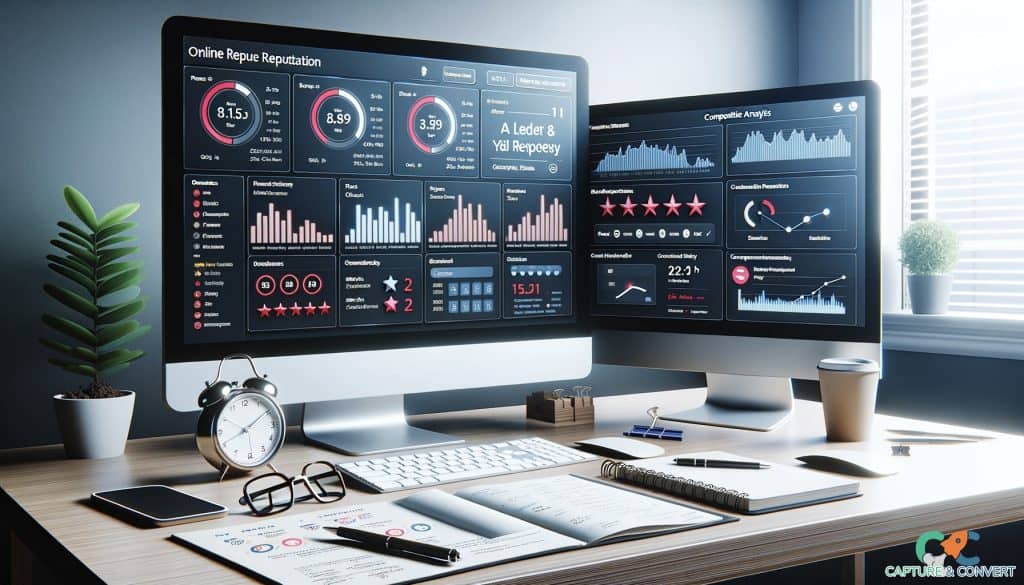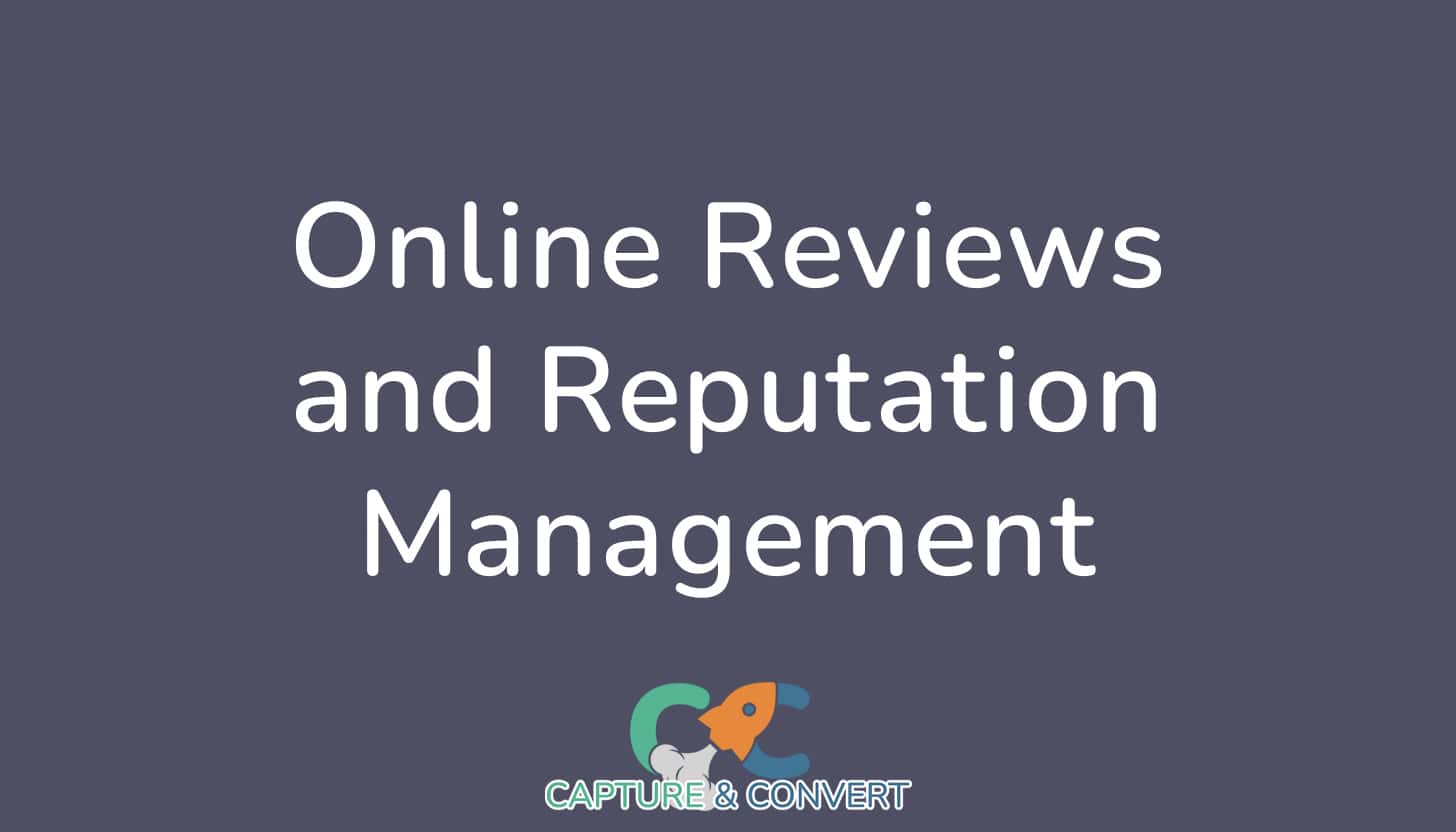Explore how online reviews shape your local reputation. Learn 11 actionable tips to harness positive feedback, manage negatives, and monitor your digital image.
Online Reputation Management (ORM) is becoming increasingly vital for businesses seeking to improve their lead generation strategy in today's digital age.
ORM involves monitoring and shaping how your brand is perceived online.
A crucial component of ORM is managing online reviews, which have grown to hold significant influence over consumers' choices.
As consumers increasingly rely on online reviews to inform their decisions, maintaining a positive online reputation becomes instrumental in generating more local leads and fostering trust within the community.
In this article, we'll explore 11 effective strategies to boost your local business's reputation via online reviews, helping you strengthen your online presence and attract more local customers.
Contents
- Importance of Online Reviews for Local Businesses
- 1. Encourage Reviews
- 2. Respond to Reviews
- 3. Implement a Review Monitoring System
- 4. Address Negative Feedback Constructively
- 5. Promote Positive Reviews
- 6. Incentivize Reviews
- 7. Regularly Update Business Profiles
- 8. Manage Fake Reviews
- 9. Educate Employees
- 10. Use Feedback for Improvement
- 11. Use Online Reputation Management Tools
- Common Mistakes in ORM
- Enhancing Online Reputation Through Local SEO
- Industries Highly Influenced by Online Reviews
- Repairing Online Reputation After
Importance of Online Reviews for Local Businesses

Online reviews hold immense importance for local businesses.
They act as a virtual word-of-mouth, influencing how your brand is perceived in the local community.
Positive reviews can establish trust and credibility, while negative ones can deter potential customers.
Moreover, reviews directly impact your local SEO efforts, with search engines often considering them a ranking factor for local search results.
The effectiveness of reviews has been documented by an April 1st 2017 research by Shankhadeep Banerjee, Samadrita Bhattacharyya and I. Bose published on Decis. Support Syst.
A strong presence on review platforms not only enhances your online reputation but also significantly contributes to attracting more local customers.
Benefits
Listed below are 6 benefits of online reviews for local businesses.
- Powerful Social Proof: Online reviews act as testimonials that validate your business and offerings.
- Builds Trust: Positive experiences shared by others build trust among potential customers.
- Boosts Reputation: Positive reviews enhance your business’s reputation, making it more appealing to local consumers.
- Provides Valuable Feedback: Reviews offer insights that can help improve products and services.
- Enhances Local SEO: Leveraging reviews can aid local SEO efforts, increasing visibility on search engines.
- Increases Local Leads: Higher visibility through positive reviews may lead to increased local customer engagement and lead generation.
Drawbacks
Listed below are 6 drawbacks of online reviews for local businesses.
- Potential for Negative Impact: Negative reviews can harm your reputation and potentially deter customers.
- Handling Negative Feedback: Managing and responding to negative reviews requires tact and can be challenging.
- Questionable Authenticity: The presence of fake or paid reviews may undermine trust in your review platform.
- Time-Consuming Management: Consistent monitoring and engagement with reviews require time and resources.
- Potential Bias: Some platforms might have biased reviews, which do not give an accurate representation of your business.
- Vulnerability to Malicious Intent: Competitors or disgruntled individuals may post malicious reviews to harm your reputation.
Nevertheless, the benefits of maintaining a strong online reputation through reviews generally outweigh the drawbacks, making them an essential aspect of local business marketing.
Listed below are 11 strategies to boost local business reputation via reviews.
- Encourage Reviews
- Respond to Reviews
- Implement a Review Monitoring System
- Address Negative Feedback Constructively
- Promote Positive Reviews
- Incentivize Reviews
- Regularly Update Business Profiles
- Manage Fake Reviews
- Educate Employees
- Use Feedback for Improvement
- Use Online Reputation Management Tools
1. Encourage Reviews

Having a substantial volume of reviews is not just about boosting your online reputation; it's a crucial factor in attracting local leads.
Local consumers often rely on the quantity and quality of reviews to make informed decisions.
Encouraging reviews and feedback from satisfied customers can significantly impact your business.
The following list describes 9 effective strategies to motivate customers to share their experiences.
- Prompt and Polite Requests: Politely ask satisfied customers to leave a review after their purchase or interaction. A timely request can result in more responses.
- Incentives: Consider offering small incentives, such as discounts or exclusive offers, to customers who leave reviews. Make sure this complies with review platform policies.
- Provide a Seamless Process: Make it easy for customers to leave reviews by providing direct links or clear instructions on where and how to do so.
- Leverage Email Marketing: Incorporate review requests into your email marketing campaigns. Send follow-up emails asking for feedback after a purchase or service completion.
- Engage on Social Media: Use your social media channels to encourage reviews. Share positive reviews you've received and ask followers to share their experiences.
- Create Review Cards or Flyers: Physical businesses can distribute review cards or flyers with QR codes or website links, making it convenient for customers to leave feedback.
- Respond to Reviews: Show your engagement by responding to reviews, both positive and negative. This demonstrates your commitment to customer satisfaction.
- Leverage Your Website: Add review widgets or sections on your website, showcasing customer feedback prominently.
- Educate Staff: Ensure that your staff is aware of the importance of reviews and encourage them to ask for feedback during interactions.
2. Respond to Reviews

Engaging with reviews, whether positive or negative, is a vital aspect of reputation management for local businesses.
Responding not only demonstrates your commitment to customer satisfaction but also influences potential leads who read these reviews.
Timely and appropriate responses can turn satisfied customers into loyal advocates and potentially convert disappointed ones into returning clients.
The following list shows how you can make the most of this strategy.
- Acknowledge Positive Feedback: Respond promptly to positive reviews with gratitude and appreciation. Personalize your responses by mentioning specific details from the review. This shows that you value your customers' feedback and can encourage them to become repeat customers or refer your business to others.
- Address Negative Reviews with Care: When handling negative reviews, it's crucial to remain composed and empathetic. Acknowledge the issue raised, apologize if necessary, and offer solutions or steps you'll take to rectify the situation. Keep in mind that your response is not just for the reviewer but for the potential customers reading it. A well-handled negative review can demonstrate your commitment to customer satisfaction and mitigate the impact of the negative feedback.
- Keep Responses Professional: Maintain professionalism in your responses. Avoid engaging in heated arguments or responding defensively, as this can reflect poorly on your business. Instead, focus on resolving the issue calmly and courteously.
- Respond Promptly: Timely responses indicate that you are actively managing your online reputation. Customers appreciate quick acknowledgment of their feedback, whether positive or negative.
- Use Brand Voice: Ensure that your responses align with your brand's tone and values. Consistency in messaging helps reinforce your brand identity.
- Encourage Further Contact: In your responses, invite customers to reach out directly if they have additional concerns. Providing contact information or a direct link to customer support can lead to problem resolution and enhance customer satisfaction.
- Monitor and Follow Up: Continuously monitor reviews and respond as needed. Follow up with customers after a resolution to ensure their satisfaction and thank them for giving your business another chance if applicable.
- Highlight Improvements: If a negative review leads to positive changes in your business, share this with reviewers. It shows your commitment to improvement and can create a positive impression.
3. Implement a Review Monitoring System

Staying informed about what customers are saying about your business across various online platforms is essential for managing your local business's reputation.
A robust review monitoring system ensures that you are promptly aware of new reviews, whether they are positive or negative.
The following list provides 10 tips on how you can effectively implement such a system.
- Utilize Review Management Tools: Invest in review management tools that can consolidate reviews from different platforms into one dashboard. Tools like Google Alerts, Hootsuite, or specialized review management software can help you keep track of customer feedback more efficiently.
- Set Up Alerts: Configure alerts or notifications for new reviews. These alerts can be sent to your email or through the review management tool, ensuring you're promptly informed when new reviews are posted.
- Monitor Multiple Platforms: Keep an eye on various review platforms relevant to your business. This includes Google Business Profile, Yelp, TripAdvisor, industry-specific platforms, and social media. Each platform can provide valuable insights into customer sentiment.
- Regularly Check and Respond: Establish a routine for checking reviews. Respond to both positive and negative reviews promptly and professionally. Timely responses demonstrate your attentiveness to customer feedback.
- Categorize and Analyze: Categorize reviews based on themes or common issues. This can help you identify recurring problems and take corrective actions to improve your business.
- Track Trends and Sentiments: Analyze reviews to identify trends in customer sentiments. Are there specific aspects of your business that customers frequently praise or complain about? Understanding these trends can guide your business improvement efforts.
- Seek Feedback Internally: Encourage your team or employees to contribute to the review monitoring process. They may come across reviews or feedback that you may have missed.
- Implement Improvements: Use the insights gained from review monitoring to implement improvements in your products, services, or customer experience. Customers appreciate businesses that actively address their concerns.
- Stay Consistent: Maintain consistency in your review monitoring efforts. Whether your business is growing or established, ongoing review monitoring is crucial for reputation management.
- Seek Professional Help: For businesses with a substantial online presence and a high volume of reviews, consider enlisting the help of reputation management professionals who specialize in monitoring and responding to reviews.
4. Address Negative Feedback Constructively

Handling negative feedback with a constructive approach can turn challenging situations into opportunities for improvement and customer satisfaction.
When handled effectively, negative feedback can become an opportunity to strengthen your business's reputation and generate more local leads.
The following list provides a step by step strategy to manage negative feedback.
- Stay Calm and Professional: Maintain a professional tone and avoid reacting emotionally to negative reviews. Responding in a calm and composed manner demonstrates your commitment to addressing concerns.
- Acknowledge the Issue: Begin your response by acknowledging the customer's concern. Express empathy and understanding for their experience, even if you believe their complaint is unfounded.
- Apologize and Take Responsibility: If your business made a mistake or the customer had a genuine issue, offer a sincere apology. Taking responsibility for any errors or lapses is a crucial step in resolving the situation.
- Provide Solutions: Offer practical solutions or steps to address the customer's concern. Be specific about what you can do to rectify the situation and improve their experience.
- Take It Offline: Encourage further discussion or resolution through private channels. Provide a contact email or phone number for the customer to reach out to you directly. This demonstrates your commitment to resolving the issue.
- Learn and Improve: Use negative feedback as an opportunity to learn and improve your business. Analyze recurring issues mentioned in reviews and take proactive measures to prevent them in the future.
- Follow Up: After addressing the concern, follow up with the customer to ensure they are satisfied with the resolution. This extra step shows your dedication to customer satisfaction.
- Highlight Positive Aspects: If appropriate, highlight positive aspects of your business in your response. This can help balance the negative feedback and showcase your strengths.
- Encourage Reevaluation: Encourage customers to reevaluate your business after the issue is resolved. A follow-up review with a positive experience can help mitigate the impact of a negative review.
- Maintain Privacy and Confidentiality: Ensure that you respect customer privacy and confidentiality in your responses, especially when dealing with sensitive issues.
- Seek Support and Training: If handling negative feedback proves challenging, consider seeking support or training in customer service and reputation management. Professional guidance can be valuable.
5. Promote Positive Reviews

Harnessing positive reviews can significantly bolster your local business's reputation and attract more local leads.
Promoting positive reviews is a delicate art that funds itself at the crossroads of excellent communication and sophisticated marketing techniques.
The following list contains 12 strategies for showcasing and leveraging positive reviews in your marketing efforts.
- Create Testimonial Collages: Gather positive reviews and create visually appealing testimonial collages. Feature these on your website, social media profiles, and marketing materials. Visual testimonials can be compelling and highlight the positive experiences of your customers.
- Include Reviews in Marketing Materials: Incorporate snippets from positive reviews in your brochures, flyers, and advertisements. Sharing real feedback from satisfied customers can build trust with potential clients.
- Leverage Social Media: Share excerpts from positive reviews on your social media platforms. Craft engaging posts that highlight customer experiences and encourage others to leave reviews as well.
- Email Marketing: Send email campaigns featuring positive reviews and customer success stories. Use these emails to showcase your business's reputation and encourage recipients to engage with your services.
- Website Integration: Embed review widgets or plugins on your website to display real-time reviews. A dedicated reviews page can serve as a hub for customers to explore the experiences of others.
- Google Business Profile Highlights: Use the Google Business Profile platform to highlight positive reviews. Respond to these reviews with gratitude and enthusiasm. Google often showcases the best reviews in your listing.
- Video Testimonials: Encourage satisfied customers to record video testimonials. Video content can be highly engaging and authentic. Share these video testimonials on your website and social media channels.
- Reward Referrers: Consider implementing a referral program that rewards customers for referring others and leaving positive reviews. This can motivate satisfied clients to actively promote your business.
- Monitor and Respond: Continuously monitor your reviews and respond promptly to new ones. Express gratitude to those who leave positive feedback. Engagement can encourage more customers to share their experiences.
- Case Studies: Develop in-depth case studies featuring the positive experiences of your clients. These comprehensive stories can provide valuable insights and demonstrate your expertise.
- Online Advertising: Consider using positive reviews in your online advertising campaigns. Displaying star ratings or snippets from reviews can enhance the click-through rate of your ads.
- Local SEO: Optimize your website and online presence with keywords related to positive customer experiences. This can improve your visibility in local search results.
6. Incentivize Reviews

Encouraging reviews through ethical incentives can be a valuable strategy for boosting your local business's reputation.
Incentivizing reviews ethically is essential to ensure that your approaches adhere to platform policies and maintain transparency.
The following list provides an overview on how to ethically incentivize reviews,
- Discounts or Coupons: Offer discounts or exclusive coupons to customers who leave reviews. Make it clear that these incentives are available to anyone, not just positive reviewers.
- Loyalty Programs: Implement loyalty programs that reward customers for repeat business and reviews. Loyalty points or rewards can motivate customers to share their experiences.
- Contests and Giveaways: Organize contests or giveaways where participants can enter by leaving reviews. Ensure that the rules explicitly state that both positive and negative reviews are eligible.
- Free Trials or Samples: Provide free trials or samples of your products or services to customers who agree to share their feedback. This allows them to experience your offerings and express their genuine opinions.
- Thank You Gifts: Send thank-you gifts to customers who take the time to leave reviews. These tokens of appreciation can foster goodwill and encourage future engagement.
- Community Involvement: Support local events or charitable causes and invite customers to participate. In return, ask them to share their thoughts on your business, creating a positive association with your brand.
- Transparency: Clearly communicate your incentive program's terms and conditions. Be transparent about your desire for honest and unbiased feedback.
- Avoiding Bias: Encourage reviewers to be honest and share their genuine experiences. Make it clear that their opinions, whether positive or negative, are valuable to your business.
- Platform Guidelines: Familiarize yourself with the specific guidelines of review platforms like Google and Yelp. Ensure that your incentive strategies align with their policies.
- Privacy Considerations: Protect customer privacy by not requesting sensitive information in exchange for incentives. Maintain data security and comply with privacy regulations.
- Follow-Up Emails: Send follow-up emails to customers after their purchase, asking for reviews without any immediate incentives. This can capture spontaneous feedback while separate incentive-driven campaigns can focus on a wider audience.
- Moderation and Fairness: Implement a fair moderation system for reviews. Avoid favoring positive reviews or suppressing negative ones, as this can harm your reputation.
7. Regularly Update Business Profiles

Consistently updating your business profiles across various online platforms plays a pivotal role in enhancing your credibility and attracting more reviews.
A stagnant or outdated profile can deter potential customers and hinder review engagement.
The following list underlines how regularly updating business profiles brings advantages.
- Trust and Reliability: An up-to-date profile sends a clear signal that your business is active, reliable, and attentive to customer needs. Customers are more likely to trust and engage with businesses that appear current and responsive.
- Accurate Information: Keeping essential information such as contact details, hours of operation, and services offered accurate and current ensures that customers can easily reach and connect with your business. Inaccurate information can lead to frustration and negative reviews.
- Search Visibility: Search engines like Google prioritize updated and well-maintained business profiles in search results. By staying current, your business is more likely to appear in local search queries, increasing its visibility to potential customers.
- Consistency Across Platforms: Consistency in your business information across various platforms, including Google Business Profile, Yelp, and social media, reinforces trust and professionalism. It also reduces the likelihood of customers encountering conflicting details about your business.
- Positive Impressions: Updated profiles with vibrant content, such as recent photos and posts, leave a positive impression on visitors. A visually appealing and informative profile can encourage customers to explore your business further and potentially leave reviews.
- Engagement Opportunities: Regular updates create opportunities for customer engagement. Posting about new products, promotions, or community involvement can prompt customers to interact with your business and share their experiences through reviews.
- Encouraging Interaction: Customers are more likely to leave reviews when they see that a business actively engages with its audience. Updating your profile and responding promptly to comments and reviews can encourage more feedback.
- Improved Ranking: Search engines consider profile activity and consistency when determining local search rankings. An updated profile can contribute to better rankings, increasing your business's chances of being discovered by local customers.
8. Manage Fake Reviews

Effectively managing fake or malicious reviews is crucial for maintaining the integrity of your online reputation.
Fake reviews can harm your business's credibility and deter potential customers.
The following actionable list with 11 steps will help business owners to identify and effectively manage malicious and fake reviews.
- Spotting Red Flags: Train your team to recognize common red flags of fake reviews, such as overly generic content, suspicious usernames, or an unusual number of reviews in a short time. Pay attention to reviews that seem unusually positive or negative.
- Reporting to Platforms: Most review platforms have mechanisms for reporting fake or malicious reviews. Encourage your team and customers to report such reviews promptly. Include guidelines on your website or in your establishment for customers to follow when reporting fake reviews.
- Engage with Reviewers: Respond to suspicious reviews with professionalism and a request for clarification. Sometimes, a polite inquiry can reveal the authenticity of a review. Genuine customers are more likely to respond and provide more context.
- Document Evidence: Keep records of interactions with reviewers and any evidence that suggests a review is fake. This documentation can be valuable when reporting the review to the platform.
- Contact the Platform: Reach out to the review platform's support team and provide them with the evidence you've collected. Explain why you believe the review is fake or malicious and request its removal.
- Addressing Legitimate Concerns: If a negative review contains valid concerns, use it as an opportunity to improve your business. Respond to the review professionally, acknowledge the concerns, and outline steps you've taken to address them. This can mitigate the impact of the negative review.
- Legal Action (if Necessary): In cases of extreme defamation or malicious intent, consult with legal counsel to explore the possibility of taking legal action against the reviewer. This step should be considered as a last resort.
- Educate Your Team: Train your staff to be vigilant about fake reviews and provide them with guidelines on how to handle suspicious feedback. Consistent vigilance can help prevent fake reviews from gaining traction.
- Proactive Review Management: Encourage satisfied customers to leave reviews to dilute the impact of fake ones. An influx of genuine positive reviews can push fake reviews down the list and make them less visible.
- Monitor Review Patterns: Use online reputation management tools to monitor review patterns and identify anomalies. Sudden spikes in reviews, especially from new or unverified accounts, can be indicative of fake reviews.
- Transparency: Maintain transparency with your customers and let them know that you actively monitor and address fake reviews to ensure the integrity of your online reputation.
9. Educate Employees

Employees are an integral part of your reputation management strategy.
Their interactions with customers can significantly impact the number and quality of reviews your business receives.
The following list explains how to emphasize the role employees play in garnering positive reviews and implement training techniques.
- Training Workshops: Organize training workshops or sessions for your employees, focusing on the importance of online reviews and their role in the process. Explain how reviews contribute to the success of the business and how positive feedback can lead to more customers.
- Customer Service Training: Provide customer service training that emphasizes creating positive experiences for customers. When employees go the extra mile to ensure customer satisfaction, it increases the likelihood of receiving positive reviews.
- Review Request Protocols: Develop clear protocols for requesting reviews from satisfied customers. Employees should know when and how to request reviews without being pushy or violating platform policies.
- Scripted Requests: Provide employees with scripted review requests that are polite and non-intrusive. These scripts can serve as a guide for asking for reviews without making customers uncomfortable.
- Incentive Programs: Consider implementing incentive programs to motivate employees to actively seek reviews. Reward employees for mentioning the importance of reviews and encouraging customers to leave feedback.
- Monitoring Online Conversations: Encourage employees to monitor online conversations about your business and to respond professionally to customer feedback, both positive and negative. Timely and courteous responses reflect positively on your business.
- Role-Playing Exercises: Conduct role-playing exercises during training to help employees practice requesting reviews and responding to different customer scenarios. This hands-on approach can boost their confidence.
- Performance Metrics: Integrate review-related performance metrics into employee evaluations. Recognize and reward employees who excel in obtaining positive reviews and managing online reputation effectively.
- Feedback Loop: Create a feedback loop where employees can share customer feedback they receive. This information can be valuable for improving products, services, and customer interactions.
- Regular Updates: Keep employees informed about changes in online review platforms and policies. Platforms occasionally update their rules, and employees should be aware of these changes to avoid unintentional violations.
- Ethical Practices: Stress the importance of ethical practices in obtaining reviews. Employees should never engage in or encourage fake reviews, as this can harm the business's reputation.
- Continuous Learning: Make online reputation management an ongoing part of employee development. Encourage them to stay updated on best practices and new strategies for obtaining reviews.
10. Use Feedback for Improvement

Using customer feedback for improvement not only enhances the customer experience but also demonstrates your commitment to listening to your audience.
Over time, this approach can lead to increased customer loyalty, positive word-of-mouth, and improved local lead generation as satisfied customers become advocates for your business.
The following list shows in 13 steps how to leverage customer feedback for continuous improvement.
- Identify Pain Points: Carefully read through reviews to identify recurring issues or pain points mentioned by customers. These could relate to product quality, service speed, staff behavior, or other aspects of your business.
- Prioritize Improvements: Once you've identified areas that need improvement, prioritize them based on the frequency and severity of mentions in reviews. Focus on addressing the most critical issues first.
- Implement Changes: Take proactive steps to address the identified problems. This might involve staff training, process improvements, or changes to products or services. Make sure your team understands the importance of these changes.
- Track Progress: Continuously monitor the impact of your improvements on customer satisfaction and the number of positive reviews. Look for trends indicating that the changes are positively affecting customer experiences.
- Respond to Feedback: Engage with customers who have left feedback about improvements. Thank them for their input and let them know about the changes you've made based on their suggestions.
- Seek Specific Feedback: Encourage customers to provide specific feedback on areas you're actively trying to improve. For example, if you've upgraded your customer service, ask for feedback on the new approach.
- Measure Customer Satisfaction: Implement methods for measuring customer satisfaction at different touchpoints in their journey with your business. This can help you identify potential issues before they become negative reviews.
- Employee Training: If feedback highlights issues with employee behavior or interactions, provide additional training and support to address these concerns.
- Product Development: Use feedback to inform product or service development. If customers consistently ask for specific features or improvements, consider incorporating these into your offerings.
- Competitive Analysis: Compare your business's reviews to those of competitors. Identify areas where you excel and where you can improve to gain a competitive edge.
- Review Analytics Tools: Utilize review analytics tools to gain deeper insights into customer sentiment and identify patterns or trends in feedback.
- Customer Surveys: Conduct customer surveys to gather more structured feedback on specific aspects of your business. Surveys can provide quantitative data to complement the qualitative insights from reviews.
- Test and Iterate: Implement changes gradually and be prepared to iterate on your improvements. Test different approaches to see what resonates best with your customers.
11. Use Online Reputation Management Tools

Using online reputation management tools for local lead generation not only helps maintain a positive online image but also contributes to building trust within your local community.
The following list provides an actionable 11 step strategy for utilizing these tools effectively.
- Choose the Right Tool: Begin by selecting a reputable reputation management tool that aligns with your business needs and budget. Popular options include ReviewTrackers, Birdeye, and Reputation.com.
- Monitor Reviews: Set up real-time review monitoring to receive alerts whenever new reviews are posted about your business. This allows you to stay on top of feedback and respond promptly.
- Aggregate Reviews: Use the tool to aggregate reviews from various platforms (Google, Yelp, TripAdvisor, etc.) into a single dashboard. This streamlines the review management process.
- Analyze Sentiment: Leverage sentiment analysis features to gauge the overall sentiment of reviews. Identify trends and areas that need improvement based on sentiment data.
- Automate Responses: Automate responses to standard reviews while reserving personalized responses for unique cases. This ensures efficient communication with customers.
- Generate More Reviews: Utilize the tool's capabilities to request reviews from satisfied customers. Customize review request templates to encourage feedback.
- Competitor Analysis: Some tools offer competitor analysis features, allowing you to benchmark your reputation against competitors in your local market.
- Reporting and Insights: Regularly review reports and insights provided by the tool. Identify areas of strength and improvement in your online reputation.
- Leverage Positive Reviews: Use the tool to identify and showcase positive reviews on your website, social media, or marketing materials. Highlight customer testimonials to build trust.
- Address Negative Feedback: Quickly address negative feedback using the tool's response features. Convert dissatisfied customers into brand advocates through excellent service recovery.
- Track Progress: Continuously track the impact of reputation management efforts on your business. Look for improvements in review ratings, sentiment, and customer engagement.
Common Mistakes in ORM
In the realm of Online Reputation Management (ORM), local businesses must tread carefully to maintain a positive image and avoiding common pitfalls is crucial.
Firstly, steer clear of ignoring customer feedback or engaging in heated online disputes, as this can further damage your reputation.
Secondly, avoid the temptation to post fake positive reviews or pay for them, as platforms and customers increasingly scrutinize authenticity.
Lastly, refrain from neglecting your online presence, including outdated information, unprofessional content, or inconsistent branding.
Proactively addressing these pitfalls ensures that ORM efforts contribute positively to local lead generation and customer trust.
Enhancing Online Reputation Through Local SEO

Local SEO, with its emphasis on accurate NAP (Name, Address, Phone Number) data, encourages consistency and trustworthiness across online platforms.
When local businesses maintain accurate and up-to-date information, they bolster their online reputation, signaling reliability to potential customers.
Moreover, local SEO practices, like optimizing meta tags and descriptions with local keywords, enhance visibility in local searches, which, in turn, can lead to more authentic and positive online reviews
A well-executed local SEO strategy, aligned with reputation management efforts, can significantly amplify a business's online presence and reputation, ultimately contributing to local lead generation and customer trust.
Review Frequency's Effect
Search engines, like Google, value fresh and recent reviews as indicators of a business's ongoing relevance and activity.
Regularly posted reviews convey that a business is active, engaged with its customers, and responsive to their feedback, which are all key factors in local search ranking algorithms.
A steady stream of reviews, especially positive ones, can push a business higher in search results, enhancing its visibility to potential customers.
Conversely, a lack of recent reviews can signal inactivity or disinterest, potentially resulting in a lower search ranking.
Therefore, encouraging customers to provide reviews consistently can be a powerful strategy for local businesses looking to improve their search visibility and attract more local leads.
Industries Highly Influenced by Online Reviews

Service-based industries such as restaurants, hotels, healthcare, and local retail businesses tend to be highly influenced by online reviews.
In these sectors, consumers heavily rely on reviews to make informed decisions due to the personal and often immediate nature of their needs.
A negative review for a restaurant, for instance, can significantly deter potential customers, while positive feedback can substantially boost business.
Conversely, industries with less immediate or personal impacts, such as manufacturing or wholesale, may be less influenced by online reviews.
However, the importance of online reputation is steadily growing across all sectors as consumers increasingly turn to the internet for guidance, making it essential for businesses to monitor and manage their online reviews, regardless of their industry.
Repairing Online Reputation After
Online reputation can be repaired after a significant PR crisis, but it often requires dedicated effort, time, and a strategic approach.
After a crisis, a business should promptly acknowledge and address the issue, taking responsibility and demonstrating a commitment to making amends.
Engaging with customers and stakeholders transparently is crucial, as is implementing corrective actions and actively seeking to prevent similar issues in the future.
Encouraging positive reviews and testimonials from satisfied customers can help counteract negative sentiment.
Over time, consistent efforts towards transparency, improvement, and rebuilding trust can lead to a positive shift in online reputation.
However, it's essential to remember that reputation repair may be an ongoing process, and maintaining a strong online presence and proactive reputation management is crucial to prevent future issues.
Online Reputation Management Services
Online reputation management (ORM) services can be effective in improving and maintaining a positive online reputation.
These services employ various strategies, including monitoring and responding to reviews, optimizing online profiles, and implementing SEO techniques to influence search results.
They can help businesses mitigate the impact of negative reviews and content while promoting positive aspects of their brand.
However, the success of ORM services depends on the provider's expertise and the specific needs of the business.
It's essential to choose a reputable ORM service that aligns with your goals and invests in ethical and sustainable practices to manage and enhance your online reputation effectively.

